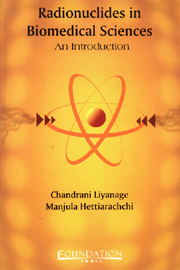Book contents
- Frontmatter
- Contents
- Forewords
- Introduction
- 1 Atomic and Nuclear Structure
- 2 Radiation Detectors
- 3 Units of Radiation Measurements
- 4 Iodine–125
- 5 Radioimmunoassay
- 6 Quality Control in RIA
- 7 Radiolabelled Compounds
- 8 Radiation Safety
- 9 Radiation Protection
- 10 Background Radiation
- 11 Storage
- 12 Contamination
- 13 Radioactive Waste
- References
7 - Radiolabelled Compounds
Published online by Cambridge University Press: 26 October 2011
- Frontmatter
- Contents
- Forewords
- Introduction
- 1 Atomic and Nuclear Structure
- 2 Radiation Detectors
- 3 Units of Radiation Measurements
- 4 Iodine–125
- 5 Radioimmunoassay
- 6 Quality Control in RIA
- 7 Radiolabelled Compounds
- 8 Radiation Safety
- 9 Radiation Protection
- 10 Background Radiation
- 11 Storage
- 12 Contamination
- 13 Radioactive Waste
- References
Summary
PREPARATION AND ASSESSMENT OF RADIOLABELLED COMPOUNDS USED AS TRACERS IN RIA
In a radioimmunoassay system, the response variable relies entirely on the measurement of the radiolabelied tracer in the bound or free fraction of the analyte, after separation. The kinetics of the reaction is entirely followed using the tracer without actually estimating the amount of analyte. Hence, it is imperative to understand the methods of preparation and purification of tracers, concept of purity, qualities of tracers used in RIAs and assessment of their qualities.
A radiolabelied molecule has a radionuclide in its structure, which disintegrates that molecule from others due to the emission of radiation that can be measured. In general, two types of radiolabelled compounds are encountered:
a. Genuinely-labelled compounds
b. Foreign-labelled compounds.
In genuinely-labelled compounds, one of the constituent atoms is replaced by a radioactive nuclide of the same element in the same position. Most compounds of clinical interest are biochemicals having C, H, N, O, P, and S as their constituents and it would be appropriate to choose a corresponding radionuclide of these elements for labelling by substitution. For example,14C or 3H in methanol and l25I in thyroxine, tri-iodothyronine etc.
Introduction of a foreign label should be done in such a way that labelled entity retains the ability to react with the antibodies. In foreign-labelled compounds, the element whose radionuclide is used for labelling is not an original constituent of the molecule. Either the radionuclide replaces an original non-reactive atom of another element or is part of large group appended to analyte molecule.
- Type
- Chapter
- Information
- Radionuclides in Biomedical SciencesAn Introduction, pp. 85 - 88Publisher: Foundation BooksPrint publication year: 2008



